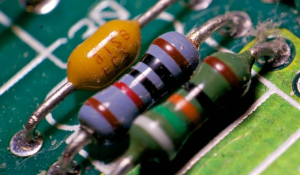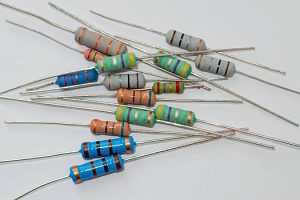Resistors are fundamental components in all kinds of electronic circuits, playing crucial roles in controlling current flow, voltage regulation, and energy dissipation. They are passive devices that limit the electric current through them and convert excess electrical energy into heat. The resistance level of resistors is measured in Ohms (Ω). This article provides an in-depth look into resistors, covering their importance, various types, key parameters, applications, and future trends.
Why Resistors Are Important
In electronic circuits, resistors act as traffic rules, controlling the flow of electric current and ensuring the proper functioning of various components. Key functions of resistors include:
- Current Limiting: Resistors restrict the flow of current to safe levels, preventing damage to delicate components. They are especially crucial when circuits are powered on, as they limit the inrush current.
- Voltage Drops: According to Ohm’s law, resistors cause a precise voltage drop across their terminals. This is essential for generating stable voltage levels required by different electronic components.
- Energy Dissipation: Resistors convert excess electrical energy into heat, a critical function in dynamic braking systems for motors.
- Sensing: Special resistors like thermistors and photoresistors change resistance based on temperature, light, or other parameters, allowing for accurate measurements.
- Signal Mixing: By combining voltage drops across resistors in series or parallel configurations, signals can be attenuated, filtered, and smoothed.
- Circuit Protection: In case of short circuits or faults, resistors limit the current flow to protect other components. Fusible resistors act as a safeguard by opening when overheated.
- Voltage Division: Resistors connected in series can create voltage dividers, generating lower voltages from a higher supply voltage.
Resistors are indispensable in ensuring the safety, stability, and functionality of electronic circuits.

Types of Resistors
Resistors can be broadly categorized into linear and non-linear types based on their resistance characteristics.
Linear Resistors
Linear resistors maintain a constant resistance value over a wide range of operating conditions. They can be further divided into fixed and variable resistors.
Fixed Resistors
These resistors have a set resistance value that remains unchanged. Common types include:
- Wire-wound Resistors: Made by winding a resistive wire, such as nichrome, around an insulating core. The resistance value is determined by the material, length, and thickness of the wire. These resistors can handle high power levels due to effective heat dissipation.
- Thin Film Resistors: Manufactured by depositing a thin metallic or ceramic film onto an insulating substrate like alumina. They are created with precise photolithographic processes, offering very low tolerance.
- Thick Film Resistors: These resistors are made by screen printing a mixture of glass frit, metals, and binders onto a ceramic substrate, which is then fired at high temperatures. They offer moderate performance at lower costs.
- Carbon Composition Resistors: Consist of finely powdered carbon mixed with a filler and an insulating binder, molded into a cylindrical shape with lead wires. While inexpensive, they tend to be noisy.
- Carbon Film Resistors: A carbon or graphite film is deposited on a ceramic rod or substrate and spiral-cut to adjust the resistance. They provide better stability than carbon composition resistors.
Variable Resistors
These resistors allow for resistance adjustment within a specified range. Types include:
- Potentiometers: Feature a movable wiper that slides over a resistive track, varying the resistance between the wiper and the terminals. They act as adjustable voltage dividers.
- Rheostats: Similar to potentiometers, but with a wiper that varies resistance over a single track, controlling current flow in devices like motors.
- Trimmer Resistors: These are preset variable resistors that can be adjusted during circuit calibration using mechanical adjustments like screw threads or sliding contacts.
Non-Linear Resistors
Non-linear resistors have resistance values that change with applied voltage, current, temperature, or other factors. They are essential for functions like surge protection and sensing. Types include:
- Thermistors: Ceramic semiconductors that exhibit significant resistance changes with temperature fluctuations. There are two main types:
- NTC (Negative Temperature Coefficient): Resistance decreases as temperature increases. Used for temperature measurement and current limiting.
- PTC (Positive Temperature Coefficient): Resistance increases sharply above a threshold temperature. Used as resettable fuses and for overcurrent protection.
- Varistors: Made from ceramics containing zinc oxide, these resistors have a highly non-linear current-voltage profile. They exhibit very high resistance below a certain voltage and low resistance above it, making them ideal for surge suppression.
- Photoresistors: Also known as light-dependent resistors (LDRs), these resistors reduce their resistance with increasing illumination. Used in light sensing applications.
- Magnetoresistors: Constructed from materials like indium antimonide or gallium arsenide, these resistors change resistance based on the strength of an applied magnetic field, useful for sensing position and speed.
- Gas Discharge Tubes: Comprise two electrodes within a gas-filled glass envelope. Below a specific voltage, they act as an open circuit. When the voltage exceeds a breakdown point, the gas ionizes, drastically reducing resistance. Used for surge protection.

Special Types of Resistors
Apart from the standard fixed, variable, and non-linear resistors, there are specialized varieties designed for specific applications:
- High Power Resistors: Typically wire-wound, metal oxide, or ceramic resistors capable of dissipating over 5 watts without overheating. They are used in motor controls and power supplies.
- High Precision Resistors: These resistors offer ultra-precision with tolerances better than 0.005%, commonly thin film types used in applications requiring high accuracy like metrology and calibration devices.
- Tapped Resistors: Feature multiple taps allowing for different resistance values by connecting various terminals. Often used in audio amplifiers and bridged measurement circuits.
- Shunt Resistors: Extremely low resistance resistors used for current sensing. The voltage drop across them is used to measure circuit current accurately.
- Fusible Resistors: Designed to act as fuses, these wire-wound resistors burn open under overload conditions to protect the circuit.
Key Resistor Parameters
Selecting the right resistor involves understanding several key specifications:
- Resistance Value (Ohms): Resistors are available from fractions of an ohm to hundreds of megaohms. Tolerances can range from ±1% to ±0.005% for high-precision resistors.
- Power Rating (Watts): Indicates the maximum power a resistor can dissipate without damage. It depends on the resistor’s mass and surface area for heat dissipation.
- Voltage Rating: The maximum continuous voltage that can be applied across the resistor.
- Temperature Coefficient: Measures how the resistance changes with temperature, crucial for maintaining performance in varying conditions.
- Tolerance: The maximum deviation from the nominal resistance value, affecting circuit precision.
- Noise: Resistors generate thermal and current noise, influenced by their materials and construction. Low noise is essential in signal processing applications.
- TCR (Temperature Coefficient of Resistance): A quantitative measure of resistance change with temperature, important for circuit stability over temperature ranges.
Practical Applications of Resistors
Resistors are used in numerous applications across various electrical and electronic systems:
- Voltage Divider Circuits: Resistors in series across a voltage source can divide it into specific fractions, useful for measurement and providing reduced voltages.
- Current Sensing: Shunt resistors convert the current flowing through them into a proportional voltage drop, allowing for accurate current measurement in meters, relays, and protection circuits.
- Waveform Clipping and Clamping: Diode clipping or Zener clamping circuits use resistor-diode combinations to modify input signal waveforms, essential in analog signal processing.
- Smoothing and Filtering: RC (resistor-capacitor) networks smooth pulsating DC and filter noise from signals, crucial in power supplies and signal conditioning.
- Active Load: In transistor amplifiers, resistors provide reliable DC loads at input and output stages, setting the operating points.
- Timing Circuits: RC networks produce time delays, used in timer relays, oscillator circuits, and signal debouncing.
- Surge Protection: Varistors or gas discharge tubes conduct heavily during voltage spikes, protecting sensitive internal electronics.
- Temperature Compensation: NTC and PTC thermistors adjust circuit parameters over temperature variations, improving stability.
- Current Limiting: Series resistors in supply lines drop voltage, restricting current flow during initial turn-on or short circuits, preventing overcurrent damage.
Future Trends in Resistors
Ongoing research aims to enhance resistors’ performance and expand their applications through advanced materials and nanoscale fabrication techniques:
- Printed Resistors: Screen printing resistive inks onto substrates like polyimide, paper, and textiles enables integration into flexible electronics and smart fabrics.
- Thin Film Resistors: Advanced deposition techniques create precise resistance films with nanometer thickness, suitable for ultra-compact surface mount resistors.
- Metal Foil Resistors: These resistors, made by etching thin metal foils, offer lower noise and parasitic effects compared to traditional resistors, enhancing high-frequency performance.
- Carbon Nanotube Resistors: Utilizing the superior mechanical and electrical properties of carbon nanotubes, these resistors are smaller and more energy-efficient.
- Gallium Nitride Resistors: Leveraging the wide bandgap of GaN, these thermistors can operate at very high temperatures with lower leakage currents than silicon-based counterparts.

Wnioski
Resistors are crucial components that facilitate control and measurement of current, generation of precise voltage levels, sensing, and circuit protection in a wide range of applications. Understanding the different types of resistors and their parameters is essential for selecting the right resistor for specific needs. As technology advances, new materials and fabrication methods will continue to enhance resistors’ capabilities, ensuring they remain vital in modern electronics.
If you need to buy or learn more, you can contact us.
